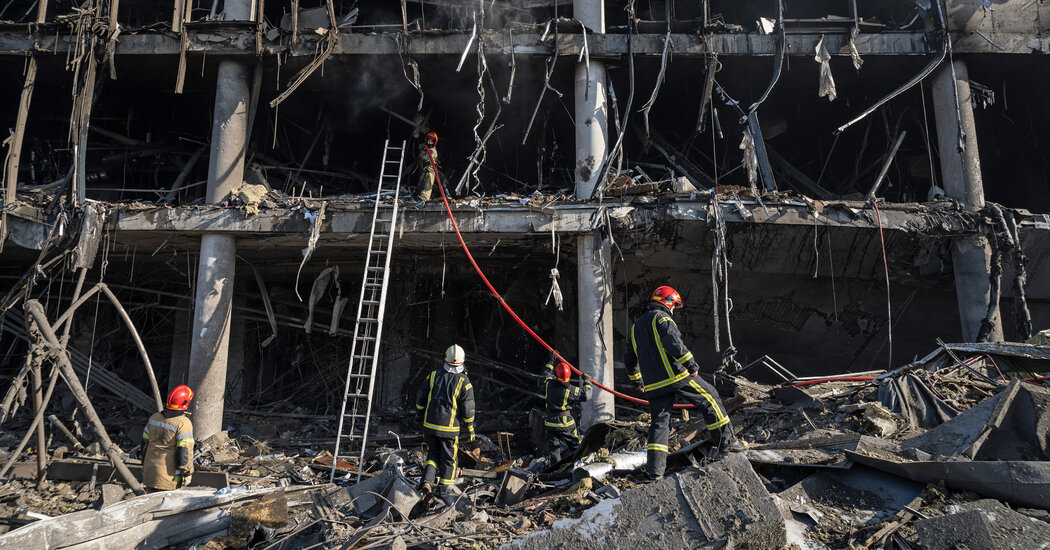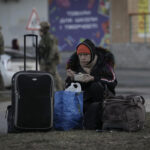
KYIV, Ukraine — Strikes on cities across Ukraine left a patchwork of death and destruction on Monday, including one that blasted a once-bustling shopping mall in Kyiv into a smoldering ruin with one of the most powerful explosions to hit the city since Russia’s war on Ukraine began.
In the besieged and ravaged southern port of Mariupol, residents braced for renewed attacks after the Ukrainian government rejected a Russian ultimatum to surrender the city.
“A neighbor said that God left Mariupol. He was afraid of everything he saw,” said Nadezhda Sukhorukova, a resident who recently escaped, adding, “my city is dying a painful death.”
The violence formed a backdrop to new consultations between the United States and its allies over how to ratchet up the pressure on Russia, with President Biden speaking by telephone with the leaders of Germany, Italy, France and Britain before heading to Brussels on Wednesday to meet NATO leaders. The alliance may take up Poland’s proposal to create an international peacekeeping force for Ukraine, an idea U.S. officials cast doubt on.
In Moscow, Russia’s foreign ministry summoned the U.S. ambassador, John J. Sullivan, on Monday to warn that Mr. Biden’s recent statements — last week he called President Vladimir V. Putin a “murderous dictator” and a “pure thug” — had put “Russian-American relations on the verge of breaking.” And in Washington, Mr. Biden urged the private sector to harden digital defenses, in light of intelligence that Russia might launch cyberattacks.
The fiery destruction of the sprawling mall in Kyiv, the capital, was the most dramatic example on Monday of Russian forces aiming artillery, rockets and bombs at civilian as well as military targets, after failing to quickly seize control of Ukraine’s major cities following the Feb. 24 invasion.
The British defense intelligence agency said on Monday that the bulk of Russian forces were more than 15 miles from the center of Kyiv and that taking the capital remained “Russia’s primary military objective.”
Given that the Ukrainians have managed to push the Russian forces back in places, frustrating that objective, Russia was resorting to long-range missiles and other weapons to bombard cities and towns, taking a growing toll in physical devastation and civilian casualties.
The Ukrainian government also accused the Russians of targeting civilians in other ways, including hijacking a desperately needed aid convoy near Kharkiv and forcibly transferring thousands of children to Russia.
Ukraine’s foreign ministry said the children had been relocated from the eastern Donbas region, where the two sides have been fighting for control over two separatist areas since 2014. Oleg Nikolenko, the ministry’s spokesman, said in a statement that 2,389 children were taken from their parents on a single day, March 19. The claim could not be independently confirmed.
In Kharkiv, the victims of Russian shelling included Boris Romantschenko, 96, who had survived the Nazi concentration camps of Buchenwald, Bergen-Belsen and Mittelbau-Dora. He died on Friday when a projectile hit his apartment building, the Buchenwald and Mittelbau-Dora Memorial Foundation said on Monday.
In the southern city of Kherson, Russian forces that have held the city since March 2 responded with violence on Monday to protesters in the main square who shouted at them to leave, according to videos and photographs verified by The New York Times. The troops’ previous response to regular protests had been sporadic gunfire in the air, but that changed to sustained gunfire for nearly a minute, shooting directly at the crowd — which scattered — and the use of flash-bang type grenades.
In Kyiv, city officials said at least eight people were killed after a Russian missile hit the mall called Retroville, in the northern part of the city, around midnight. The toll was expected to rise. The blast was so powerful that it blew debris hundreds of yards in every direction, shook buildings and flattened one part of the mall, a sporting goods store called Sport City.
Roughly eight hours after the strike, firefighters were still battling pockets of flames while soldiers and emergency crews searched the rubble. Six bodies covered with plastic lay on the pavement beside one of the mall’s sliding glass entry doors.
Closer to the crater left by the explosion, the damage was too extensive to recognize much beyond mangled metal, concrete and smoldering car engines blown out of ruined vehicles. One fireman told another that deeper in the debris he had found “a hand, a leg and other bits.”
The Retroville mall hosted a multiplex movie theater, a fitness club and fast food restaurants like McDonald’s and KFC, and an H&M outlet, although it had been closed since the start of the war. An office building next door was still standing, but all its windows were shattered and it had ignited.
A soldier at the scene said a unit of volunteers in the Territorial Defense Forces had been quartering at the mall, and that some had died along with security guards.
While Kyiv has been under bombardment for weeks, the scope of the devastation around the mall was greater than anything The Times has witnessed inside the city limits.
Roksana Tsarenko, 27, an accountant, stood by the edge of the debris field, surveying the mayhem. She had last been inside the mall a month ago to watch “Marry Me,” starring Jennifer Lopez. “You are living an ordinary life, and then, all at once, life isn’t normal anymore,” she said.
Now all of Kyiv is involved in the defense of the capital, a once-thriving metropolis turned into a fortress.
Elsewhere in the city, Oleg Sentsov, a filmmaker who was imprisoned for years in Russia due to his opposition to the annexation of Crimea in 2014, said he had evacuated his family and then joined the territorial defense, already fighting in the suburbs of Kyiv.
“The Ukrainian people have been reborn,” said Mr. Sentsov, dressed in camouflage fatigues.
“Of course the war is terrible,” he added, “and many people are dying, but there is a feeling that our nation is being born and our connections to Russia are being cut.”
Russia-Ukraine War: Key Developments
Russia had set a deadline of dawn on Monday for the surrender of Ukrainian soldiers defending the strategic southern port of Mariupol, the main city that lies between the eastern portions of Ukraine controlled by Moscow and the Crimean peninsula that Russia occupied in 2014.
The city has been cut off from water, electricity and communications, and the fierce fighting has made it almost impossible to escape. The city is less than 40 miles from the Russian border, and any effort to create an unbroken land bridge stretching from Russia to Crimea would hinge on controlling Mariupol.
A Ukrainian official accused Russian forces of firing on buses evacuating women and children from the city. Four children were injured, including one seriously, Oleksandr Staruch, the head of the Zaporizhzhia Regional State Administration, said on Monday.
Russia has repeatedly denied hitting civilian targets, even in the face of mounting evidence of homes, offices and other structures being leveled. An air strike last week destroyed a theater in Mariupol and one on Sunday hit a school in the city; each had been used to shelter hundreds of civilians.
In a rare firsthand account, Ms. Sukhorukova, a Mariupol resident who managed to escape, described what she called a living “hell” with terrifying attacks at night — the almost constant roar of planes and sounds of explosions overhead as she sat in darkness underground.
“The dead lie in the entrances, on the balconies, in the yards. And you’re not scared one bit,” Ms. Sukhorukova wrote on Facebook in a series of posts after she escaped late last week. “Because the biggest fear is night shelling. Do you know what night shelling looks like? Like death.”
There have been few first-person accounts of what the estimated 300,000 people trapped in the city have endured. The only international journalists who had remained were a team from The Associated Press, but they said on Monday they were forced to flee after learning that Russian troops were searching for them.
The blasts sounded like “a huge hammer is pounding on the iron roof and then a terrible rattle, as if the ground was cut with a huge knife, or a huge iron giant walks in forged boots on your land and steps on houses, trees, people,” Ms. Sukhorukova said.
Venturing out onto the streets looking for water, her hair matted from days without bathing, she said she dreamed of two things: “not to get shot and to take a hot shower before I die.”
It is not clear how Poland’s plan for a peacekeeping mission to Ukraine might work, given repeated statements by the United States and NATO officials that they would not send troops to defend Ukraine. In the past such missions were only deployed after the fighting had ended.
On Thursday, Mr. Biden will join a European Council summit meeting and a G7 meeting called by Germany to discuss further sanctions against Mr. Putin, as well as aid for the more than three million people who have fled Ukraine.
On Friday, he will visit Poland, a NATO member that borders Ukraine and Russia and the country that is the main destination for refugees. Jen Psaki, the White House press secretary, said there are no plans for Mr. Biden to travel to Ukraine.
Andrew E. Kramer reported from Kyiv and Neil MacFarquhar from New York. Reporting was contributed by Megan Specia in Krakow, Poland, Carlotta Gall in Kyiv, Marc Santora in Lviv, Glenn Thrush and John Ismay in Washington, Anton Troianovski in Istanbul, Ivan Nechepurenko, Dmitriy Khavin, Haley Willis and Ainara Tiefenthäler.




